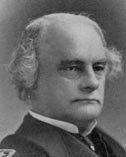John Rodgers was a military navigator, explorer, and surveyor; a leader of the U.S. Naval Observatory; and a founding member of the National Academy of Sciences.
Descended from a family that had distinguished itself during the Revolutionary War and in subsequent military service, Rodgers entered the U.S. Navy at age 16 as a midshipman and performed his first tour in the Mediterranean. When his ship returned to the United States, Rodgers entered the Naval School in Virginia for one year and then University of Virginia for a year. He was ordered to sea again and for more than a decade he promoted American interests in Florida, the Mediterranean, Africa, and Asia.
Rodgers was given command of his first vessel in 1852 to lead an exploration of the North Pacific. When the Civil War began, he was given charge of a new ironclad ship, the Weehawken, which led the successful attack on Fort Sumter. After being promoted to rear admiral in 1869, Rodgers became superintendant of the U.S. Naval Observatory, which was in a state of disrepair and located on the Potomac River. Rodgers decided to rebuild the observatory in Georgetown Heights, where it is located still today.
Rodgers also served as president of the Transit of Venus Commission , which led a project to determine the scale of our solar system by tracking with photographic equipment the transit of Venus across the Sun; as president of the first Naval Advisory Board, which recommended improvements to the U.S. fleet ; and as chairman of the Lighthouse Board, which oversaw the construction and maintenance of lighthouses on U.S. coastline.



